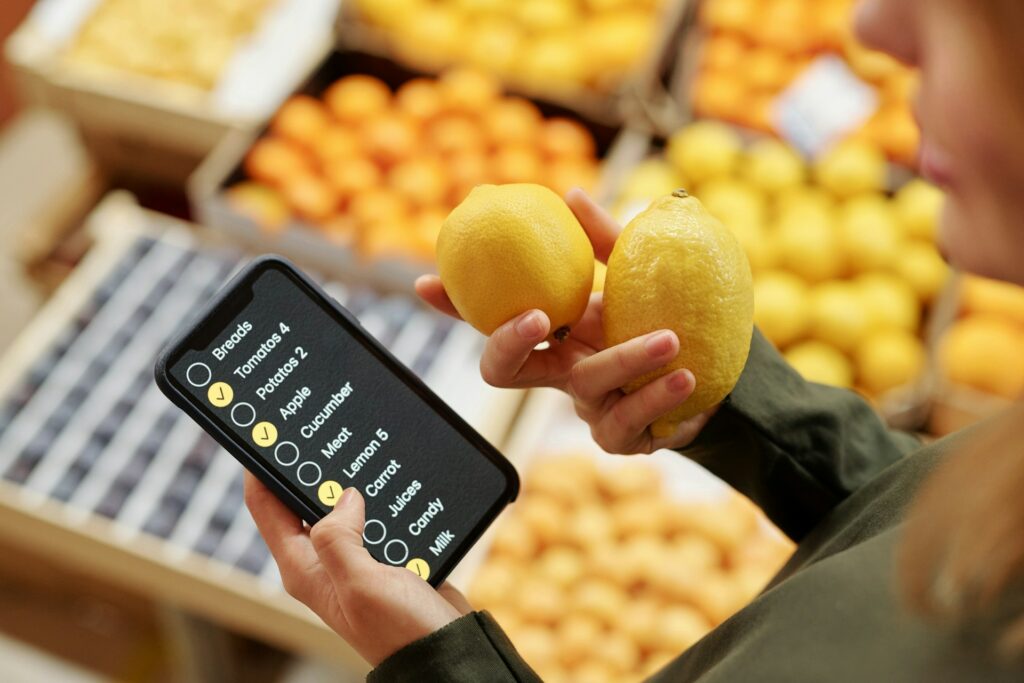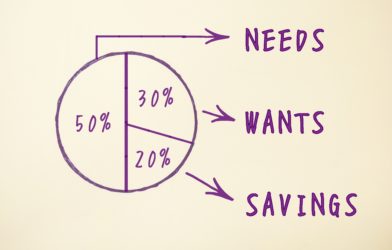Grocery prices keep going up, and many families are feeling the pinch. But don’t worry! There are lots of ways to save money on food without going hungry. There are also lots of influencers across social media offering their advice on how to stretch your budget at the supermarket. We turned to nine popular YouTube influencers to come up with some consensus hacks they’re using to save the most money on groceries.
Here are 11 tips we came away with to help you cut your grocery bill:
1. Make a Shopping List
Before you go to the store, write down everything you need. This helps you avoid buying things you don’t really need. A good strategy is to use a “revolving shopping list” on your phone. Add items to the list when you’re running low, even if you don’t need to buy them right away. This way, you’ll always know what you have at home and what you need to buy.
For example, Sarah keeps a list on her phone using a note-taking app. When she uses the last of her olive oil, she adds it to the list. She doesn’t buy it right away, but when she sees it on sale next time, she knows to pick it up. This method helps her avoid buying duplicates of things she already has and ensures she never runs out of essentials.

To make your revolving list even more effective, organize it by store sections (produce, dairy, meats, etc.). This will make your shopping trip faster and more efficient. You can also add notes about usual prices, so you know when something is a good deal.
Remember, the key to a successful shopping list is to stick to it! Allow yourself one small treat that’s not on the list if you want, but try to avoid impulse buys. These unplanned purchases can quickly blow your budget.
2. Plan Your Meals
Decide what you’re going to eat for the week before you go shopping. This helps you buy only what you need and use everything you buy. It also stops you from buying takeout because you don’t know what to cook.
The Johnson family sits down every Sunday to plan their meals for the week. They start by checking what’s already in their fridge and pantry. Then, they look at the store flyers to see what’s on sale. They plan their meals around these sale items and what they already have. Finally, they make a shopping list for the ingredients they still need.

When meal planning, try to think of ways to use ingredients in multiple meals. For example, if chicken is on sale, the Johnsons might plan for grilled chicken on Monday, chicken tacos on Wednesday, and chicken soup on Friday. This way, they can buy in bulk and save money.
Don’t forget to plan for leftovers too. The Johnsons often make extra food at dinner to use for lunches the next day. This saves them time and money.
Remember, your meal plan doesn’t have to be fancy. Simple meals are often cheaper and quicker to make. The goal is to have a plan so you’re not tempted to order expensive takeout or buy overpriced convenience foods.
3. Buy What’s on Sale
Look at the store flyers or apps to see what’s on sale each week. Plan your meals around these items to save money. Most items go on sale about once every four weeks, so buy extra when the price is low.
Mike has become an expert at shopping the sales. He notices that ground beef is on sale this week for $3.99 per pound, down from the usual $5.99. He buys enough for several meals and freezes what he won’t use right away. He knows ground beef will probably not be this cheap again for about a month.

To make the most of sales, it’s important to know what a good price is for the items you buy regularly. Keep a price book (either a physical notebook or an app on your phone) where you write down the lowest prices you see for your common purchases. This way, you’ll know a good deal when you see one.
Don’t be afraid to stock up on non-perishable items when they’re on sale. If your favorite pasta sauce is half off and you know you’ll use it, buy extra. Just make sure you have the storage space and will use it before it expires.
Remember, though, that something isn’t a good deal just because it’s on sale. Only buy sale items that you’ll actually use. A great price on something that ends up in the trash is still a waste of money.
4. Use Coupons and Cash Back Apps
Look for coupons in the newspaper or online. Also, use apps like Fetch, Ibotta, or Upside to get cash back on your purchases. These small savings can really add up over time.
Lisa uses the Fetch app to scan her receipts after every shopping trip. She earns points for her purchases, especially when she buys featured products. After a few months, she has enough points for a $20 gift card to use on her next shopping trip. It only takes her a few seconds to scan each receipt, but the savings add up.
To maximize your savings, try to combine coupons with sales. For example, if cereal is on sale and you have a coupon for that brand, you can save even more. Some stores even allow you to use both a store coupon and a manufacturer’s coupon on the same item, known as “stacking.”

Don’t forget about digital coupons either. Many stores now offer digital coupons that you can load directly to your store loyalty card. This saves you the hassle of clipping paper coupons.
Remember, though, that coupons are only a good deal if you were going to buy that item anyway. Don’t let coupons tempt you into buying things you don’t need or wouldn’t normally use.
5. Buy Store Brands
Store brand products are often much cheaper than name brands, but the quality is usually just as good. Give them a try – you might be surprised!
Tom was skeptical about store brands at first. He always bought name-brand cereal for $4 a box. One day, he decided to try the store brand, which was only $2.50. To his surprise, his kids didn’t even notice the difference. Now, he buys store brand for most of his groceries and estimates he saves about $50 a month.
It’s worth noting that many store brand products are actually made by the same manufacturers as the name brands. They’re just packaged differently and sold for less. The quality is often identical.
Start by trying store brands for basic items like flour, sugar, or canned vegetables. If you like them, gradually expand to trying more store brand products. However, if there’s a particular name brand item that you strongly prefer, it’s okay to stick with it. The goal is to save money overall, not to make yourself miserable.
Remember, different stores have different quality store brands. If you don’t like one store’s version of something, try another store’s brand before giving up on store brands altogether.
6. Buy in Bulk (Sometimes)
Buying larger sizes can often save you money per ounce or per pound. But be careful – only buy in bulk if you’ll use it all before it goes bad.
Maria buys a 10-pound bag of rice instead of a 2-pound bag. It costs more upfront ($15 instead of $4), but she saves $5 overall and knows her family will use it all before it goes bad. However, she doesn’t buy perishables in bulk because her small family can’t eat them fast enough.
When considering buying in bulk, always check the unit price. This is usually listed on the price tag on the shelf and shows how much the item costs per ounce or per pound. Sometimes, surprisingly, the larger size isn’t actually cheaper per unit.
Bulk buying works best for non-perishable items or things you use frequently. Good candidates include rice, pasta, canned goods, paper products, and cleaning supplies. For perishables, only buy in bulk if you can freeze or preserve the excess.
Consider splitting bulk purchases with friends or family if you can’t use it all yourself. This way, you all get the savings without the risk of waste.
7. Shop at Different Stores
No single store has the best prices on everything. If you have the time, shop at a few different stores to get the best deals.
Jenny has turned grocery shopping into a money-saving art. She buys her produce at the local farmer’s market, where she finds the freshest fruits and vegetables at great prices. She gets her meat at a discount grocery store that specializes in reduced-price items. For pantry staples, she goes to the big supermarket that has the best prices on those items.
To make multi-store shopping work, you need to know which stores have the best regular prices on the items you buy most often. Keep a list of these prices for comparison. Also, consider the cost of gas and your time when deciding if an extra trip is worth it.
Don’t forget about non-traditional grocery sources. Drugstores often have good deals on certain food items, especially when combined with their loyalty programs. Dollar stores can be great for certain pantry staples. Even online retailers like Amazon can sometimes have the best prices on certain non-perishable items.
Remember, though, that your time is valuable too. If going to multiple stores is stressing you out or taking too much time, it might not be worth it. Find a balance that works for you.
8. Buy Frozen Vegetables
Fresh veggies can be expensive, especially when they’re not in season. Frozen vegetables are often cheaper and just as healthy. They also last longer, so you waste less food.
Dave used to buy fresh bell peppers for $3 each, but he found he often didn’t use them all before they went bad. Now, he buys a bag of frozen mixed peppers for $2. He uses them in stir-fries and omelets all week long, and the rest stay good in the freezer for next time. He estimates this switch alone saves him about $10 a week.

Frozen vegetables are typically flash-frozen at peak ripeness, which means they’re often more nutritious than fresh vegetables that have been shipped long distances and sat on store shelves. They’re also pre-chopped, which saves you time in the kitchen.
Some vegetables freeze better than others. Peas, corn, broccoli, and spinach are all great frozen. However, vegetables with high water content, like lettuce or cucumbers, don’t freeze well. For these, stick to fresh but buy only what you need for the week.
Don’t forget about frozen fruits too. They’re great for smoothies and baking, and they’re often much cheaper than fresh, especially for out-of-season fruits.
9. Reduce Meat Consumption
Meat is often the most expensive part of a meal. Try having one or two meatless meals each week, or use less meat and add beans or vegetables to stretch it further.
The Garcia family used to eat meat every night. Now they have “Meatless Monday” and make veggie chili or bean burritos, saving about $10 per week. They’ve also started using less meat in their other meals. For example, instead of making tacos with a full pound of ground beef, they use half a pound of beef and add a can of black beans. Nobody notices the difference, and it significantly cuts their grocery bill.
When you do buy meat, look for less expensive cuts. Chicken thighs are often cheaper than breasts, and they’re more flavorful. Tough cuts of beef like chuck or round are much less expensive than steak, and they’re perfect for slow-cooker meals.
Consider using meat as a flavoring rather than the main event. For example, use a small amount of bacon to flavor a vegetable soup, or add a bit of chicken to a largely vegetable-based stir-fry.
Don’t forget about plant-based protein sources. Beans, lentils, eggs, and tofu are all much less expensive than meat and can be the base of delicious, filling meals.
10. Avoid Convenience Foods
Pre-cut fruits and vegetables, individual snack packs, and ready-made meals cost a lot more than making things from scratch. If you have the time, prep your own foods to save money.
Amy used to buy pre-cut fruit salad for $6 for a small container. Now, she buys whole fruits for $3 and spends 10 minutes cutting them up herself. She estimates this saves her about $15 a week, and the fruit stays fresh longer too.
The same principle applies to many other convenience foods. Instead of buying individual yogurt cups, buy a large tub and portion it out yourself. Rather than pre-made frozen dinners, cook extra when you make dinner and freeze individual portions for quick meals later.
For snacks, buy large bags of items like pretzels or crackers and portion them out into reusable containers instead of buying individual snack packs. This not only saves money but also reduces packaging waste.
Remember, though, that your time is valuable too. If having some convenience foods helps you avoid ordering takeout, it might be worth the extra cost. Find a balance that works for your budget and lifestyle.
11. Start a Pantry Challenge
Once a month, try to make meals using only what you already have in your pantry and freezer. This helps you use up food before it goes bad and saves you from buying more groceries that week.
The Wilson family does a pantry challenge the last week of every month. They get creative with meals and often discover forgotten foods in the back of the cupboard. One month, they found a can of chickpeas and some tahini and made homemade hummus. Another time, they used up some slightly stale bread by making French toast. They estimate they save about $100 each month by doing this.
To make a pantry challenge easier, keep an inventory of what’s in your pantry and freezer. Update it regularly. This way, you can meal plan based on what you already have without having to dig through everything.

Don’t be afraid to get creative during your pantry challenge. Look up recipes based on the ingredients you have on hand. You might discover some new favorite meals this way.
Remember, the goal of a pantry challenge isn’t to eat poorly, but to use what you have creatively. If you’re missing a key ingredient for a meal, it’s okay to buy that one thing. The point is to minimize your shopping and use up what you already have.
Bottom Line For Your Bottom Line
By using these tips, you can save a lot of money on your grocery bill. Remember, small changes can add up to big savings over time. Don’t get discouraged if you can’t do everything at once – even using just one or two of these ideas can help your budget.
It’s also important to remember that feeding your family comes first. Don’t feel bad if you sometimes need to buy convenience foods or can’t always get the healthiest options. Doing your best with what you have is what counts.
With a little planning and smart shopping, you can keep your family well-fed without breaking the bank. Happy saving!












